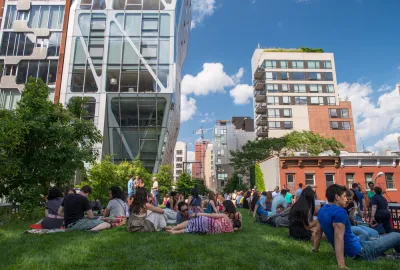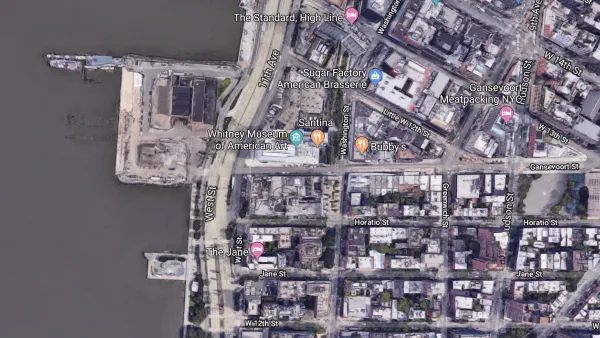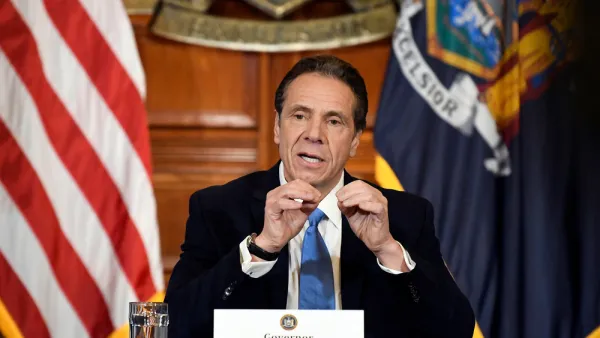As the High Line turns ten, a debate about the costs and benefits of urban revitalization continues.

Karrie Jacobs writes about the tenth anniversary of the High Line in New York City, admitting a rediscovered appreciation for the sometimes maligned, but always widely admired, piece of adaptive reused public space.
That renewed appreciation, writes Jacobs, was gained from the perspective offered from the High Line's new neighbor at Hudson Yards, the much less admired Vessel.
Aspects of the elevated walkway that felt overdesigned a decade ago—the benches that sometimes appear to grow directly out of the pavement, the seating areas that step downward toward views of the street, the careful plantings, the blocks of cement with carefully spaced cracks in between—now struck me as generous. Maybe it’s because so much of the world seems contrived today, but there’s a sincerity to it, an honest desire to respond to the needs of the public, to draw them in, to inspire their curiosity, to make them notice the underlying structure of the park, the artworks interspersed with the plantings, and also—maybe especially—to observe the surrounding city.
Jacobs's renewed appreciation of the High Line contrasts with the criticisms of Justin Davidson published earlier this year.
Today, the High Line serves as an elevated cattle chute for tourists, who shuffle from the Whitney to Hudson Yards, squeezed between high glass walls and luxury guard towers. The views are mostly gone, which is a good thing because stopping to admire one would cause a 16-pedestrian pileup. The rail-level traffic mirrors the congestion overhead, caused by construction so hellbent on milking New York’s waning real estate hyper-boom that any patch of land bigger than a tick’s front yard is considered suitable for luxury condos.
Jacobs endeavors to counter other criticisms, too—like the idea that "this park, every new urban park, is an evil act of alchemy." That argument misses an important point, according to Jacobs, about what the neighborhoods around the High Line have become, and what they might have become without the High Line being built.
Would New York be better or worse off without the High Line? The answer depends on whether we (those of us not in the market for a $48 million penthouse, anyway) get any value out of having buildings by Hadid, BIG, Heatherwick, and other luminaries in our city. If the alternative scenario would be the High Line as an undeveloped industrial ruin, surrounded by a West Chelsea of taxi garages and low-rent artists, I’d say screw the starchitects. But the more likely scenario, assuming the High Line hadn’t been restored, would be something that resembles Riverside South, a mostly residential complex some 30 blocks uptown along another disused railroad property. A lineup of 19 buildings with little to recommend them architecturally, they nevertheless remain largely unaffordable to most of us. The High Line, for better or worse, created a context for a kind of residential architecture that hadn’t previously existed in New York City. We couldn’t have gotten the park without the development, but we could easily have gotten the development without the park.
In the end, Jacobs decides that the High Line is an open-air museum of the present moment. The city is radically different than it was ten years ago, Jacobs writes, and the High Line is where to go to immerse in the city of New York as it exists today.
FULL STORY: The High Line at 10

Analysis: Cybertruck Fatality Rate Far Exceeds That of Ford Pinto
The Tesla Cybertruck was recalled seven times last year.

National Parks Layoffs Will Cause Communities to Lose Billions
Thousands of essential park workers were laid off this week, just before the busy spring break season.

Retro-silient?: America’s First “Eco-burb,” The Woodlands Turns 50
A master-planned community north of Houston offers lessons on green infrastructure and resilient design, but falls short of its founder’s lofty affordability and walkability goals.

Test News Post 1
This is a summary

Analysis: Cybertruck Fatality Rate Far Exceeds That of Ford Pinto
The Tesla Cybertruck was recalled seven times last year.

Test News Headline 46
Test for the image on the front page.
Urban Design for Planners 1: Software Tools
This six-course series explores essential urban design concepts using open source software and equips planners with the tools they need to participate fully in the urban design process.
Planning for Universal Design
Learn the tools for implementing Universal Design in planning regulations.
EMC Planning Group, Inc.
Planetizen
Planetizen
Mpact (formerly Rail~Volution)
Great Falls Development Authority, Inc.
HUDs Office of Policy Development and Research
NYU Wagner Graduate School of Public Service



























